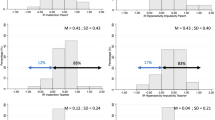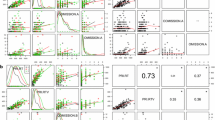Abstract
The current study was aimed at (a) investigating the effect of three doses methylphenidate (MPH) and placebo on inhibition of a prepotent response, inhibition of an ongoing response, and interference control in Attention Deficit/Hyperactivity Disorder (AD/HD), and (b) studying dose-response relations for the three forms of response inhibition. To meet these aims, the following tasks were selected: two versions of the Stop Paradigm for inhibition of a prepotent response, a Circle Tracing Task and a recently developed Follow Task for inhibition of an ongoing response, and the Stroop Color-Word Test and an Eriksen Flanker Task for interference control. These tasks were administered to 23 boys with AD/HD during four treatment conditions: 5 mg MPH, 10 mg MPH, 20 mg MPH, and placebo. A pseudorandomized, multiple-blind, placebo-controlled, within-subject design was used. As hypothesized, inhibitory control in children with AD/HD improved under MPH compared to placebo. However, this effect was only significant for inhibition of a prepotent response and inhibition of an ongoing response (as measured by the Follow Task), but not for interference control. The relation between treatment condition and response was linear. However, this linear relation was due to improved inhibitory control under MPH compared to placebo, because no effects of MPH dose were observed for any of the response inhibition measures.
Similar content being viewed by others
References
American Psychiatric Association. (1994). Diagnostic and statistical manual of mental disorders (4th ed.). Washington, DC: Author.
Bachorowski, J. A., & Newman, J. P. (1985). Impulsivity in adults: Motor inhibition and time-interval estimation. Personality and Individual Differences, 6, 133-136.
Bachorowski, J. A., & Newman, J. P. (1990). Impulsive motor behavior: Effects of personality and goal salience. Journal of Personality and Social Psychology, 58, 512-518.
Band, G. P. H., van der Molen, M. W., & Logan, G. D. (in press). Horse-race model simulations of stopping: Good news for stop-signal reaction time but bad news for slope of the inhibition function. Acta Psychologica, xxx, xxx-xxx.
Barkley, R. A. (1997a). ADHD and the nature of self-control. New York: Guilford Press.
Barkley, R. A. (1997b). Behavioural inhibition, sustained attention, and executive functions: Constructing a unifying theory of AD/HD. Psychological Bulletin, 121, 65-94.
Carter, C. S., Krener, P., Chaderjian, M., Northcutt, C., & Wolfe, V. (1995). Abnormal processing of irrelevant information in attention deficit hyperactivity disorder. Psychiatry Research, 56, 59-70.
Chhabildas, N., Pennington, B. F., & Willcutt, E. G. (2001). A comparison of the neuropsychological profiles of the DSM-IV subtypes of ADHD. Journal of Abnormal Child Psychology, 29, 52-540.
Douglas, V. I., Barr, R. G., Amin, K., O'Neill, M. E., & Britton, B. G. (1988). Dosage effects and individual responsivity to methylphenidate in attention deficit disorder. Journal of Child Psychology and Psychiatry, 29, 453-475.
Eriksen, B. A., & Eriksen, C. W. (1974). Effects of noise letters upon the identification of a target letter in a nonsearch task. Perception and Psychophysics, 16, 143-149.
Everett, J., Thomas, J., Cote, F., Levesque, J., & Michaud, D. (1991). Cognitive effects of psychostimulant medication in hyperactive children. Child Psychiatry and Human Development, 22, 79-87.
Goldman, L. S., Genel, M., Bezman, R. J., & Slanetz, P. J. (1998). Diagnosis and treatment of Attention-Deficit/Hyperactivity Disorder. JAMA, 279, 1100-1107.
Groth-Marnat, G. (1997). Handbook of psychological assessment (3rd ed.). New York: Wiley.
Halperin, J. M., McKay, K. E., Matier, K., & Sharma, V. (1994). Attention, response inhibition, and activity level in children: Developmental neuropsychological perspectives. In M. G. Tramontana & S. R. Hooper (Eds.), Advances in child neuropsychology (Vol. 2, pp. 1-54). New York: Springer-Verlag.
Hammes, J. W. G. (1971). De Stroop Kleur-Woord Test. Handleiding [The Stroop Color-Word Test: Manual]. Lisse: Swets & Zeitlinger.
Hartman, C. A., Hox, J., Mellenbergh, G. J., Boyle, M. H., Offord, D. R., Racine, Y., et al. (2001). DSM-IV internal construct validity: When a taxonomy meets data. Journal of Child Psychology and Psychiatry, 42, 817-836.
Jonkman, L. M., Kemner, C., Verbaten, M. N., van Engeland, H., Kenemans, J. L., Camferman, G., et al. (1999). Perceptual and response interference in children with attention-deficit hyperactivity disorder, and the effects of methylphenidate. Psychophysiology, 36, 419-429.
Konrad, K., Gauggel, S., Manz, A., & Schöll, M. (2000). Inhibitory control in children with traumatic brain injury (TBI) and children with attention deficit/hyperactivity disorder (ADHD). Brain Injury, 14, 859-875.
Kooijmans, R., Scheres, A., & Oosterlaan, J. (2001). Response inhibition and measures of psychopathology: A dimensional analysis. Child Neuropsychology, 6, 175-184.
Kuntsi, J., Oosterlaan, J., & Stevenson, J. (2001). Psychological mechanisms in hyperactivity: I. Response inhibition deficit, working memory impairment, delay aversion, or something else? Journal of Child Psychology and Psychiatry, 42, 199-210.
Logan, G. D. (1994). On the ability to inhibit thought and action: A users' guide to the stop signal paradigm. In D. Dagenbach & T. H. Carr (Eds.), Inhibitory processes in attention, memory, and language (pp. 189-239). San Diego: Academic Press.
Logan, G. D., & Cowan, W. B. (1984). On the ability to inhibit thought and action: A theory of an act of control. Psychological Review, 91, 295-327.
Logan, G. D., Schachar, R. J., & Tannock, R. (1997). Impulsivity and inhibitory control. Psychological Science, 8, 60-64.
MacLeod, C. M. (1991). Half a century of research on the Stroop effect: An integrative review. Psychological Bulletin, 109, 163-203.
Manassis, K., Tannock, R., & Barbosa, J. (2000). Dichotic listening and response inhibition in children with comorbid anxiety disorders and ADHD. Journal of the American Academy for Child and Adolescent Psychiatry, 39, 1152-1159.
McBurnett, K. (2000). Methylphenidate treatment of DSM-IV types of Attention Deficit Hyperactivity Disorder. In L. L. Greenhill & B. B. Osman (Eds.), Ritalin: Theory and Practice (2nd ed.), pp. 253-263). Larchmont: Mary Ann Liebert.
Morein-Zamir, S., & Meiran, N. (in press). Individual stopping times and cognitive control: Converging evidence from a new stop signal paradigm. Quarterly Journal of Experimental Psychology, xx, xxx-xxx.
MTA cooperative group. (1999). A 14-month randomized clinical trial of treatment strategies for Attention-Deficit/Hyperactivity Disorder. Archives of General Psychiatry, 56, 1073-1086.
Nigg, J. T. (1999). The ADHD response-inhibition deficit as measured by the stop task: Replication with DSM-IV combined type, extension, and qualification. Journal of Abnormal Child Psychology, 27, 393-402.
Nigg, J. T. (2000). On inhibition/disinhibition in developmental psychopathology: Views from cognitive and personal psychology and a working inhibition taxonomy. Psychological Bulletin, 126, 1-27.
Nigg, J. T. (2001). Is ADHD a disinhibitory disorder? Psychological Bulletin, 127, 571-598.
Oosterlaan, J., Logan, G. D., & Sergeant, J. A. (1998). Response inhibition in AD/HD, CD, comorbid AD/HD+CD, anxious, and control children: A meta-analysis of studies with the stop task. Journal of Child Psychology and Psychiatry, 39, 411-425.
Oosterlaan, J., Scheres, A., Antrop, I., Roeyers, H., & Sergeant, J. A. (2000). Vragenlijst voor Gedragsproblemen bij Kinderen (VvGK). Nederlandse bewerking van de Disruptive Behavior Disorders Rating Scale [Disruptive Behavior Disorder Rating Scale. Dutch translation of the Disruptive Behavior Disorders Rating Scale]. Lisse: Swets Test Publishers.
Osman, A., Kornblum, S., & Meyer, D. E. (1986). The point of no return in choice reaction time: Controlled and ballistic stages of response preparation. Journal of Experimental Psychology: Human Perception and Performance, 12, 243-258.
O'Toole, K., Abramowitz, A., Morris, R., & Dulcan, M. (1997). Effects of methylphenidate on attention and nonverbal learning in children with Attention-Deficit Hyperactivity Disorder. Journal of the American Academy of Child and Adolescent Psychiatry, 36, 531-538.
Pelham, W., Gnagy, E. M., Greenslade, K. E., & Milich, R. (1992). Teacher ratings of DSM-III-R symptoms for the disruptive behavior disorders. Journal of the American Academy of Child and Adolescent Psychiatry, 31, 210-218.
Pennington, B. F., & Ozonoff, S. (1996). Executive functions and developmental psychopathology. Journal of Child Psychology and Psychiatry, 37, 51-87.
Perugini, E. A., Harvey, E. A., Lovejoy, D. W., Sandstrom, K., & Webb, A. H. (2000). The predictive power of combined neuropsychological measures for Attention-Deficit/Hyperactivity Disorder in children. Child Neuropsychology, 6, 101-114.
Pliszka, S. R., Liotti, M., & Woldorff, M. G. (2000). Inhibitory control in children with Attention-Deficit/Hyperactivity Disorder: Event-related potentials identify the processing component and timing of an impaired right-frontal response-inhibition mechanism. Biological Psychiatry, 48, 238-246.
Rapport, M. D., & Kelly, K. L. (1991). Psychostimulant effects on learning and cognitive function: Findings and implications for children with Attention Deficit Hyperactivity Disorder. Clinical Psychology Review, 11, 61-92.
Ridderinkhof, K. R., van der Molen, W., Band, G., & Bashore, T. R. (1997). Sources of interference from irrelevant information: A developmental study. Journal of Experimental Child Psychology, 65, 315-341.
Rubia, K., Taylor, E., Smith, A. B., Oksannen, H., Overmeyer, S., & Newman, S. (2001). Neuropsychological analyses of impulsiveness in childhood hyperactivity. British Journal of Psychiatry, 179, 138-143.
Schachar, R., Mota, V. L., Logan, G. D., Tannock, R., & Klim, P. (2000). Conformation of an inhibitory control deficit in Attention-Deficit/Hyperactivity Disorder. Journal of Abnormal Child Psychology, 28, 227-235.
Schachar, R., & Tannock, R. (1993). Childhood hyperactivity and psychostimulants: A review of extended treatment studies. Journal of Child and Adolescent Psychopharmacology, 3, 81-97.
Scheres, A., Oosterlaan, J., & Sergeant, J. A. (2001a). Response execution and inhibition in children with AD/HD and other disruptive disorders: The role of behavioural activation. Journal of Child Psychology and Psychiatry, 42, 347-357.
Scheres, A., Oosterlaan, J., & Sergeant, J. A. (2001b). Response inhibition in children with DSM-IV subtypes of AD/HD and related disruptive disorders: The role of reward. Child Neuropsychology, 7, 172-191.
Seidman, L. J., Biederman, J., Mounteaux, M. C., Weber, W., & Faraone, S. V. (2000). Neuropsychological functioning in nonreferred siblings of children with Attention Deficit/Hyperactivity Disorder. Journal of Abnormal Psychology, 109, 252-265.
Sergeant, J. A., Oosterlaan, J., & Van der Meere, J. (1999). Information processing in Attention-Deficit/Hyperactivity Disorder. In H. C. Quay & A. E. Hogan (Eds.), Handbook of Disruptive Behavior Disorders (pp. 75-104). New York: Plenum.
Sergeant, J. A., & van der Meere, J. J. (2000). Ritalin: An energetic factor? In L. L. Greenhill & B. B. Osman (Eds.), Ritalin: Theory and practice, (2nd ed.), pp. 321-340). Larchmont: Mary Ann Liebert.
Shaffer, D., Fisher, P., Lucas, C. P., Dulcan, M. K., & Schwab-Stone, M. E. (2000). NIMH Diagnostic Interview Schedule for Children version IV (NIMH DISC-IV): Description, differences from previous versions, and reliability of some common diagnoses. Journal of the American Academy of Child and Adolescent Psychiatry, 39, 28-38.
Solanto, M. V., Abikoff, H., Sonuga-Barke, E., Schachar, R., Logan, G. D., Wigal, T., et al. (2001). The ecological validity of delay aversion and response inhibition as measures of impulsivity in AD/HD: A supplement to the NIMH multimodal treatment study of AD/HD. Journal of Abnormal Child Psychology, 29, 215-228.
Sprague, R. L., & Sleator, E. K. (1977). Methylphenidate in hyperkinetic children: Difference in dose effects on learning and social behavior. Science, 198, 1274-1276.
Stroop, J. R. (1935). Studies of interference in serial verbal reactions. Journal of Experimental Psychology, 18, 643-662.
Swanson, J. M., McBurnett, K., Christian, D. L., & Wigal, T. (1995). Stimulant medications and the treatment of children with ADHD. In T. H. Ollendick & R. J. Prinz (Eds.), Advances in clinical child psychology. New York: Plenum.
Tannock, R., Schachar, R. J., Carr, R. P., Chajczyk, D., & Logan, G. (1989). Effects of methylphenidate on inhibitory control in hyperactive children. Journal of Abnormal Child Psychology, 17, 473-491.
Tannock, R., Schachar, R., & Logan, G. (1995). Methylphenidate and cognitive flexibility: Dissociated dose effects in hyperactive children. Journal of Abnormal Child Psychology, 23, 235-266.
Van der Meere, J., Gunning, B., & Stemerdink, N. (1999). The effect of methylphenidate and clonidine on response inhibition and state regulation in children with ADHD. Journal of Child Psychology and Psychiatry, 40, 291-298.
Wilcutt, E. G., Pennington, B. F., Boada, R., Ogline, J. S., Tunick, R. A., Chhabildas, N. A., et al. (2001). A comparison of the cognitive deficits in reading disability and Attention-Deficit/Hyperactivity Disorder. Journal of Abnormal Psychology, 110, 157-172.
Author information
Authors and Affiliations
Rights and permissions
About this article
Cite this article
Scheres, A., Oosterlaan, J., Swanson, J. et al. The Effect of Methylphenidate on Three Forms of Response Inhibition in Boys with AD/HD. J Abnorm Child Psychol 31, 105–120 (2003). https://doi.org/10.1023/A:1021729501230
Issue Date:
DOI: https://doi.org/10.1023/A:1021729501230




